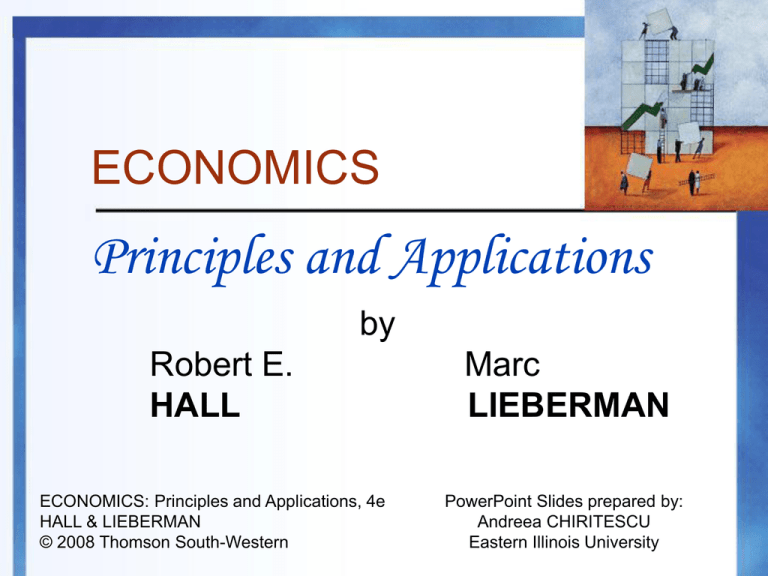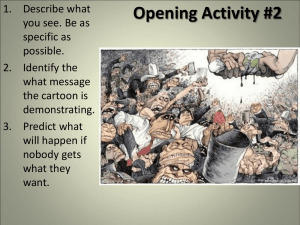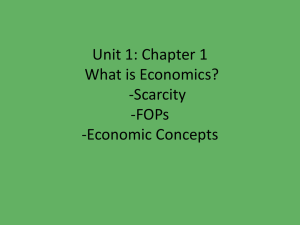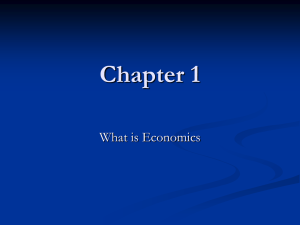Ch.1
advertisement

ECONOMICS Principles and Applications by Robert E. HALL ECONOMICS: Principles and Applications, 4e HALL & LIEBERMAN © 2008 Thomson South-Western Marc LIEBERMAN PowerPoint Slides prepared by: Andreea CHIRITESCU Eastern Illinois University Chapter 1 What is Economics ? Overview • What is economics? Definition, scarcity, and choice The world of economics o Micro vs. Macro o Positive vs. Normative Why and how to study economics The methods of economics • Math review 3 Economics, Scarcity, and Choice • Economics – Study of choice under conditions of scarcity • Scarcity – Situation in which the amount of something available is insufficient to satisfy the desire for it 4 Scarcity and Individual Choice • Unlimited variety of scarcities, based on two basic limitations: 1. Scarce time – Limited number of hours in each day to satisfy our desires 2. Scarce – spending power Cannot afford to buy more of the things we want 5 Scarcity and Individual Choice • Limitations force each of us to make choices • Economists study – Choices – Consequences of those choices – Indirect effects of individual choice on our society 6 Scarcity and Social Choice • Society faces a scarcity of resources • Categories of resources: – Labor – Capital • Human capital • Capital stock – Land/natural resources – Entrepreneurship 7 Scarcity and Economics • Problems studied in economics: the scarcity of resources—and the choices it forces us to make – Households – have limited income to allocate among goods and services – Firms – production is limited by costs of production – Government agencies – the budget is limited, so goals must be carefully chosen 8 Scarcity and Economics • Economists study the decisions made by households, firms, and governments to – Explain how our economic system operates – Forecast the future of our economy, – Suggest ways to make that future even better 9 Microeconomics • Micro comes from the Greek word mikros, meaning “small” • Studies the behavior of individual households, firms, and governments – Choices they make – Interaction in specific markets • Focuses on individual parts of an economy 10 Macroeconomics • Macro comes from the Greek word makros, meaning “large” • Studies the behavior of the overall economy • Focuses on big picture and ignores fine details 11 Positive and Normative Economics • Positive economics: how the economy works – Can be true or false – Can be tested by looking at the facts • Normative economics: what should be – Value judgments, identify problems, and prescribe solutions – Cannot be proved or disproved by the facts alone 12 Why Economists Disagree • The difference of opinion may be positive in nature – Facts are being disputed • The disagreement can be normative – Facts are not being disputed • When economists have different values, they may arrive to different conclusions • Disagreement - over goals and values 13 Why Study Economics • To understand the world better – Global events and personal phenomena • To achieve social change – Understand the origins of social problems – Design more effective solutions 14 Why Study Economics • To help prepare for other careers – A wide range of careers deal with economic issues on many levels • To become an economist – Develop a body of knowledge that could lead you to become an economist in the future 15 The Methods of Economics • Use economic models to develop economic theories • Economic models are built with words, diagrams, and mathematical statements • Economic models – Abstract representation of reality – Should be as simple as possible to accomplish its purpose 16 Economic Models: Assumptions and Conclusions • Two types of assumptions: – Simplifying assumptions • Essential features can stand out more clearly – Critical assumptions • Affect the conclusions of a model in important ways • If critical assumptions are wrong, the model will be wrong 17 The Three Step Process • Economists follow the same three-step process to analyze almost any economic problem: – The first two steps explain how economists build an economic model – The last step explains how they use the model. 18 Math, Jargon, and Other Concerns… • Economic jargon – Special words that allow economists to more precisely express themselves • Math – High school level algebra and geometry • We will covers some of the basic math concepts that you will need tomorrow 19 How to Study Economics • Economics must be studied actively, not passively • Active study – Reproduce what you have learned – List the steps in each logical argument – Retrace the cause-and-effect steps – Draw the graphs – Basic principles • relate to what you are learning 20 Math Review • Tables and graphs – Tables – Straight-line graphs – Curved lines • • • Linear equations Lines and curves shift Shifts vs. movements along a line 21 Tables and Graphs • TABLE A.1 Advertising and Sales at Len & Harry’s 22 Straight-line Graphs • FIGURE A.1 A Graph of Advertising and Sales Sales ($1,000 per month) 54 51 E 39 36 D C 27 24 F B A 18 2 3 6 7 11 12 Advertising ($1,000 per month) 23 Straight-line Graphs • Slope of a straight line = Change in vertical variable / Change in horizontal variable Y = X 24 Curved Lines • FIGURE A.2 Measuring the Slope of a Curve Sales ($1,000 per month) 1. The slope of this curve at point B… 32 31 C 27 B 24 21 18 4. sales increase from 21 to 27 units (ΔY= 6). So the curve's slope at point B is =6/3= 2. D 2. is the slope of the straight line tangent to the curve at point B. H A 3. Along the tangent line, when advertising increases from 0 to 3 units (ΔX = 3) 1 2 3 4 5 6 7 8 9 Advertising ($1,000 per month) 25 Linear Equations • • • • Y = a+bX a: vertical intercept b: slope Exercise: what is the linear equation for advertisement example in Figure A.1? • Y = 18+3X 26 Linear Equations • Remember : Y= 18+3X • For example, how much expenses are necessary to secure a sale $39,000? • Y = $39 now • $39 = 18 + 3X • X = (39 – 18)/3 = 7 27 Linear Equations FIGURE A.3 Straight Lines with Different Slopes and Vertical Intercepts Y Y b>0 a>0 a 0 X 0 X 28 Linear Equations FIGURE A.3 Straight Lines with Different Slopes and Vertical Intercepts Y Y b=0 a a=0 0 X 0 X 29 Linear Equations FIGURE A.3 Straight Lines with Different Slopes and Vertical Intercepts Y Y a b<0 0 X 0 X a<0 30 Line Shift • FIGURE A.4 Shifts in the Graph of Advertising and Sales Sales ($1,000 per Month) July 44 C' June 36 C September C'' 6 Advertising ($1,000 per Month) 31 Curves Shift • FIGURE A.5 Shifts of Curved Lines a) b) Y Y C’ C C C’ An increase in Z causes an increase in Y at any value of X X An increase in Z causes a decrease in Y at any value of X X 32 Shifts vs. Movements Along a Line • Suppose Y is the dependent variable, which is measured on one of the axis. If the independent variable measured on the other axis changes, we move along the line. • But if any other independent variable changes, the entire line shirts. Practice Question 1 50 40 30 20 y=16-4x 10 y=12-4x y=15-5x 0 0 1 2 3 4 5 -10 -20 -30 34 Practice Question 2 SAT on Hours 1600 1400 1200 1000 800 600 400 200 0 0 20 40 60 80 100 120 35 Practice Question 3 Readers on Advertising 160 140 120 100 80 60 40 20 0 0 5 10 15 20 25 30 36









